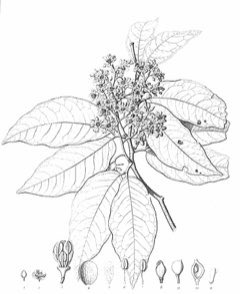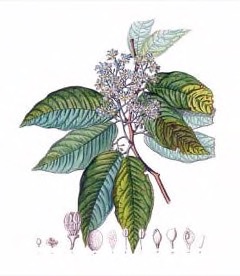 |
|
http://www.edibleplants.org |
 |
| http://www.edibleplants.org |
Translate this page:
Summary
Commonly found in South America particularly in Brazil, Venezuela, Guyana, and Trinidad and Tobago, Purpleheart or Peltogyne floribunda is a semi deciduous tree that is a major source of purpleheart wood. The wood is extremely hard and heavy, strong, and highly durable. It is well known for its color, which is often purple. It is of high quality, thus highly valued and is relatively expensive. The wood yields an aromatic resin that has medicinal properties and used to produce a red dye for textile fabrics. Peltogyne floribunda has no known edible part but it has a wide range of other uses. Its bark is used for making canoes. It has an umbrella-shaped canopy and a straight, cylindrical, buttressed bole that can be up to 90cm in diameter and unbranched for up to 25m.
Physical Characteristics

 Peltogyne floribunda is a deciduous Tree growing to 25 m (82ft) by 20 m (65ft) at a medium rate.
Peltogyne floribunda is a deciduous Tree growing to 25 m (82ft) by 20 m (65ft) at a medium rate.
See above for USDA hardiness. It is hardy to UK zone 10.
It can fix Nitrogen.
Suitable for: medium (loamy) and heavy (clay) soils and prefers well-drained soil. Suitable pH: mildly acid, neutral and basic (mildly alkaline) soils. It cannot grow in the shade. It prefers dry or moist soil.
UK Hardiness Map
US Hardiness Map
Synonyms
Hymenaea floribunda Kunth Hymenaea latifolia Hayne Peltogyne latifolia Benth. Peltogyne porphyrocard
Plant Habitats
Edible Uses
References More on Edible Uses
Medicinal Uses
Plants For A Future can not take any responsibility for any adverse effects from the use of plants. Always seek advice from a professional before using a plant medicinally.
An aromatic resin extracted from the wood is used in medicine[378 ].
References More on Medicinal Uses
The Bookshop: Edible Plant Books
Our Latest books on Perennial Plants For Food Forests and Permaculture Gardens in paperback or digital formats.

Edible Tropical Plants
Food Forest Plants for Hotter Conditions: 250+ Plants For Tropical Food Forests & Permaculture Gardens.
More

Edible Temperate Plants
Plants for Your Food Forest: 500 Plants for Temperate Food Forests & Permaculture Gardens.
More

More Books
PFAF have eight books available in paperback and digital formats. Browse the shop for more information.
Shop Now
Other Uses
Dye Furniture Resin Wood
Other Uses An aromatic resin is extracted from the wood[378 ]. It is used in medicine, as a substitute for turpentine, and to produce a red dye for dying textile fabrics[378 ]. The bark of mature trees is used by local people for making canoes[378 ]. The heartwood is a greyish purple when freshly cut, later becoming a violet purple to deep purple through an oxidation process and then slowly darkening to an attractive deep brown; it is clearly demarcated from the 5 - 10cm thick layer of creamy white to light pinkish cinnamon streaked with light brown sapwood. The uniform texture varies from fine to medium; the grain is usually straight and seldom interlocked, but is sufficiently irregular, along with variation in lustre and colour, to give the wood a pleasing stripe figure on the quarter-cut surface; lustre is medium, somewhat greasy in appearance, and cold to the touch; no distinctive odour or taste is present in seasoned wood. The wood is very hard, extremely heavy, strong, tough, and very durable in the soil, but it is most often recognized for its unusual colouring, which at times is actually purple. In due time, the purplish colour is lost and the wood turns a permanent attractive dark brown. However, the exterior brown colour is only at the surface and by removing a thin layer the original colouring can be restored. Unfortunately, the oxidation process will again prevail, turning the wood first to purple and later to a walnut brown and finally to a black-brown colour with age. It seasons somewhat slowly, with only a slight risk of checking and distortion; once dry it is moderately stable in service. The wood is moderately difficult to work with either hand or machine tools, for the wood resists cutting and dulls cutting edges. It also exudes a gummy resin when heated by dull tools; this resin clings to cutter teeth and other tool parts and complicates the machining operations. Straight-grained material saws and planes well if sharp tools are used, but some care is required on irregular-grained material to prevent pick-up, especially on the radial surface. The wood turns smoothly and requires but little sanding to bring out a good finish. It is easily fastened by gluing and takes stain and either wax or French polish well, but its purple colour is dissipated by spirit polishes. A lacquer finish is reported to hold this purple colouring. The wood splits when nailed and requires preboring; it can be veneered with a hot glue. A relatively expensive, high-quality wood, it should, in general, be put into one of two uses: (1) Those requiring wood of great strength, particularly the ability to withstand strain and sudden shocks; and (2) those requiring wood of unusual beauty or colouring[378 , 848 ]. Because of its unique shades and peculiar variegated or mottle colour effect, it is particularly well adapted for use in turnery, marquetry, cabinets, ornamental furniture, counters, office desks, counter tops, carving, inlaying, billiard cue butts, swagger sticks, panelling, decorative handles, veneer parquet flooring, handles, billiard tables, and other similar uses. The good mechanical characteristics of the wood fits it for such specialized uses as gymnasium apparatus, diving boards, skis, mill rollers, shafts, and tool handles. Purpleheart is considered Brazil? s best timber for spokes in cart wheels. Because the wood has dimensional stability, it is used in the tropics for window frames and sliding shades. Though expensive, its high strength, hardness, and resistance to decay qualify it for structural purposes, house framing, bridging, fresh water piling, and for many other parts of house construction from millwork to flooring and siding[378 ].
Special Uses
References More on Other Uses
Cultivation details
A plant of low elevations in the tropics, in at least part of its range it receives a mean annual rainfall of 1,500 - 1,750mm[378 ].
References Carbon Farming Information and Carbon Sequestration Information
Temperature Converter
Type a value in the Celsius field to convert the value to Fahrenheit:
Fahrenheit:
The PFAF Bookshop
Plants For A Future have a number of books available in paperback and digital form. Book titles include Edible Plants, Edible Perennials, Edible Trees,Edible Shrubs, Woodland Gardening, and Temperate Food Forest Plants. Our new book is Food Forest Plants For Hotter Conditions (Tropical and Sub-Tropical).
Shop Now
Plant Propagation
Seed -
Other Names
If available other names are mentioned here
Purpleheart, pau-roxo - Portuguese, zapatero - Spanish.
Native Range
SOUTHERN AMERICA: Trinidad and Tobago (Trinidad), Guyana, Venezuela (Bolívar, Monagas, Sucre, Delta Amacuro), Brazil (Roraima)
Weed Potential
Right plant wrong place. We are currently updating this section.
Please note that a plant may be invasive in one area but may not in your area so it's worth checking.
Conservation Status
IUCN Red List of Threatened Plants Status : This taxon has not yet been assessed

Growth: S = slow M = medium F = fast. Soil: L = light (sandy) M = medium H = heavy (clay). pH: A = acid N = neutral B = basic (alkaline). Shade: F = full shade S = semi-shade N = no shade. Moisture: D = dry M = Moist We = wet Wa = water.
Now available:
Food Forest Plants for Mediterranean Conditions
350+ Perennial Plants For Mediterranean and Drier Food Forests and Permaculture Gardens.
[Paperback and eBook]
This is the third in Plants For A Future's series of plant guides for food forests tailored to
specific climate zones. Following volumes on temperate and tropical ecosystems, this book focuses
on species suited to Mediterranean conditions—regions with hot, dry summers and cool, wet winters,
often facing the added challenge of climate change.
Read More
Expert comment
Author
(Kunth) Benth.
Botanical References
Links / References
For a list of references used on this page please go here
A special thanks to Ken Fern for some of the information used on this page.
Readers comment
| Add a comment |
|
If you have important information about this plant that may help other users please add a comment or link below. Only comments or links that are felt to be directly relevant to a plant will be included. If you think a comment/link or information contained on this page is inaccurate or misleading we would welcome your feedback at [email protected]. If you have questions about a plant please use the Forum on this website as we do not have the resources to answer questions ourselves.
* Please note: the comments by website users are not necessarily those held by PFAF and may give misleading or inaccurate information.
To leave a comment please Register or login here All comments need to be approved so will not appear immediately.
|
Subject : Peltogyne floribunda
|
|
|
|